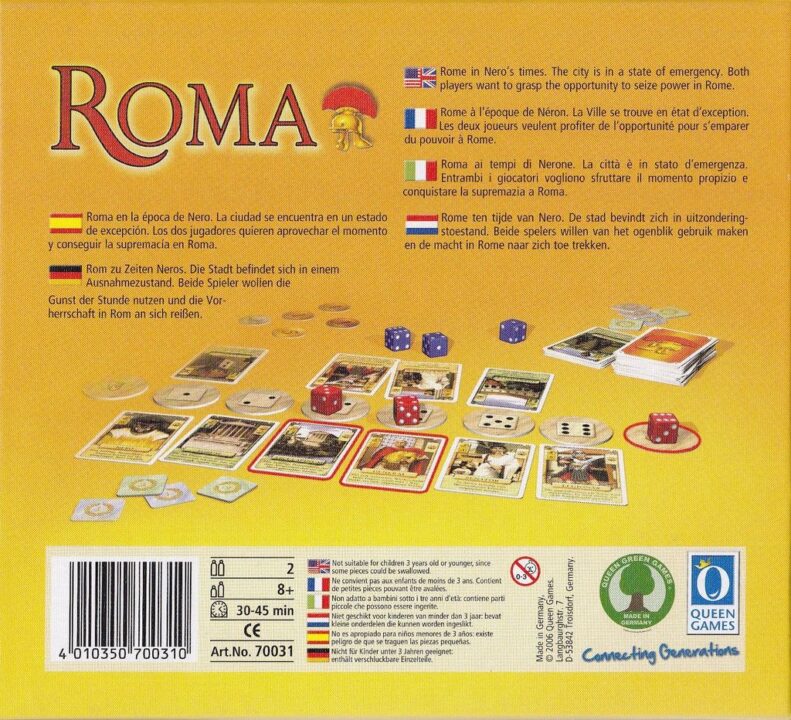Hey there, fellow board game enthusiasts! Today, I’m excited to share my thoughts on an intriguing game that’s been gracing my table recently: Roma. In this review, we’ll explore the game mechanics, player interaction, balance, replayability, fun factor, and even the component quality and design. Buckle up and get ready for a journey through ancient Rome with dice and cards!
How It Plays
Setting Up
Set up Roma in a jiffy! Place the game board between players, each player gets a set of dice and four columns from the same color. Shuffle the deck of cards and deal four to each player. Place the remaining deck face down. You are ready to roll (literally)!
Gameplay
Players take turns rolling three dice each. Use the dice to activate your cards, gain gold, or draw more cards. The number on the dice corresponds to the numbered slots on the game board. Smart moves and a bit of strategy will see you through Rome’s rise and fall. Watch out for those with high attack values; they pack a punch!
Winning the Game
Drumroll, please! You win by reducing your opponent’s influence to zero. Influence is represented by markers, and you start with ten each. Lose all markers and it’s game over for you. If the deck runs out, the player with the most influence wins. Keep that influence high and crush your opponent!
Want to know more? Read our extensive strategy guide for Roma.
Understanding Game Mechanics and Rules
Ah, game mechanics and rules! The bread and butter of any board game. Let’s talk about Roma and what makes its mechanics tick. First off, the game uses a clever mix of card and dice mechanics that can be both thrilling and maddening—sometimes, both at once!
In Roma, each player has a set of dice they roll at the beginning of their turn. The numbers on these dice determine which of their cards they can activate. This adds a layer of strategy and luck. You can’t always rely on your favorite card to come through, and that keeps things spicy. But let’s be real, sometimes the dice just aren’t on your side. I once had a game where my dice seemed to conspire against me. My friends still laugh about it. Needless to say, luck plays a role, and not everyone is a fan of that.
The rules are easy to grasp but tough to master. Each card has unique abilities that can shift the game in your favor or mess up your opponent’s strategy. This leads to some delightful moments of ‘Did you just do that?’ Yes, I did, and it felt glorious. However, be prepared for the learning curve: remembering what each card does and when to use it can be a challenge, especially for new players.
Roma also includes a victory point system, which adds another layer of tactics. You’re not just looking to survive; you’re aiming for those sweet, sweet victory points. This keeps everyone engaged and focused throughout the game.
In the next part, we’ll chat about player interaction and balance. Spoiler: things can get heated!
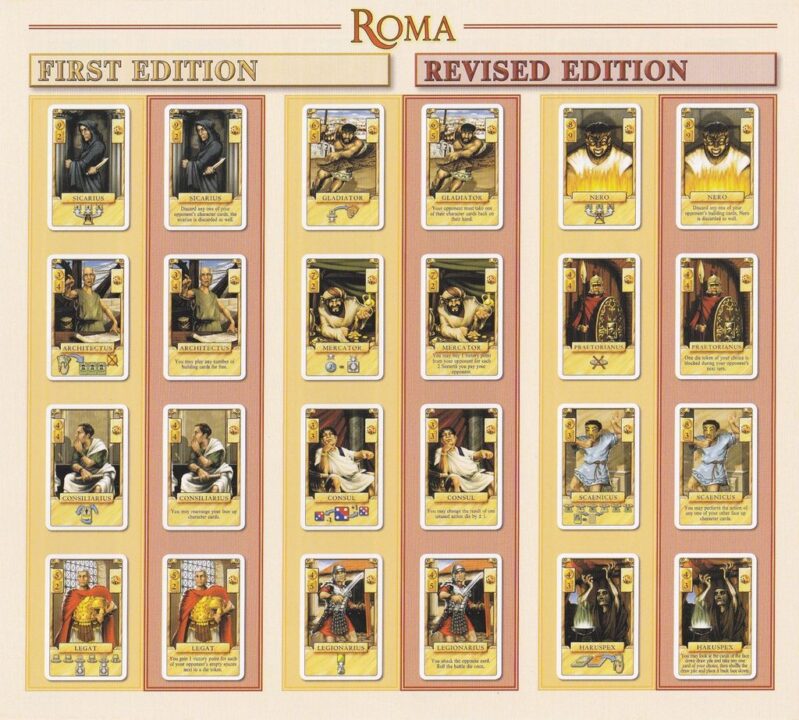
Player Interaction and Balance in Roma
Let me tell you, the player interaction in Roma had us in stitches! Imagine a game night where smack talk and strategy blend seamlessly. One minute, you’re plotting your next move, the next, you’re convincing your best friend that they should definitely use their legionary. The back-and-forth is fantastic, and it’s one of the shining aspects of this game. You don’t only play against the game mechanics; you play against each other.
Now, onto balance. Many games out there can feel like a coin toss. Not Roma. The game is a mix of strategy and luck, but the balance feels just right. You can make smart decisions and really steer the game in your favor. Yet, there’s still enough unpredictability to keep everyone on their toes. The way the cards and dice work together ensures that no one has an unfair advantage.
I once had a game where I was down to my last few points, with everyone thinking I was out. But a lucky roll turned the tide in my favor. Success in Roma requires a blend of careful planning and just enough luck to keep things exciting. But if you hate games where luck plays too big a role, you might find this a bit frustrating.
One thing to keep an eye on is the runaway leader problem. It can happen, but our group usually found ways to pull back into contention. Everyone stays engaged, which is a big win in my book.
Next up, get ready to hear how often you’ll want to break this game out and how much fun you’ll have each time!
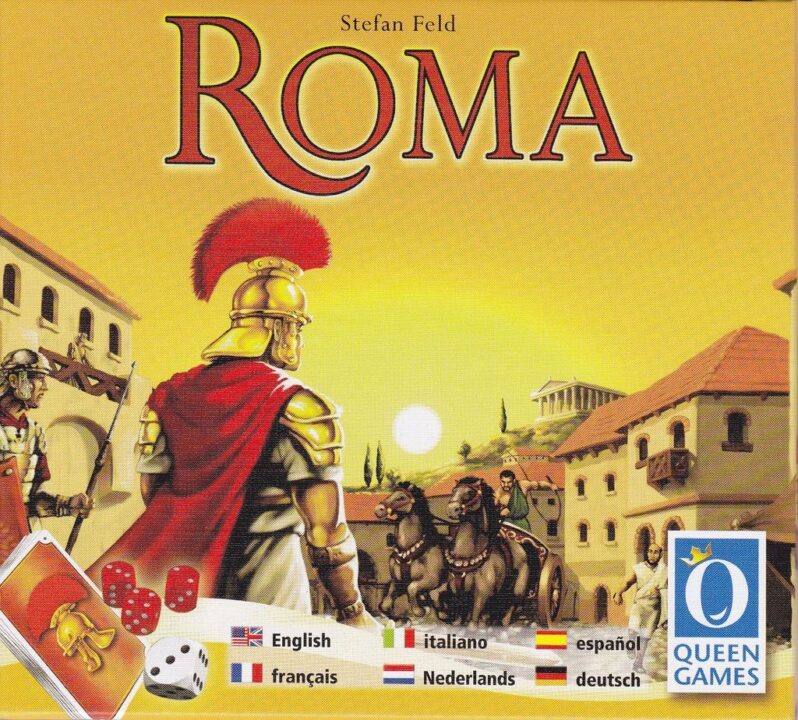
Replayability and Fun Factor
Now, let’s talk about replayability and the fun factor in Roma. I’ve played this game with my friends more times than I can count, and it never gets old. Each session brings new surprises and strategies. The game forces you to adapt, which keeps it fresh.
In Roma, you always feel like you’re on the edge of glory or disaster, which adds to the thrill. The different character cards and their abilities mean no two games are the same. You could play Roma ten times and still find new combos and tactics.
One time, I was sure I had the game in the bag, only for my friend to pull a crazy move that turned the tide. We laughed for ages! These unpredictable moments make Roma so much fun.
However, the game isn’t perfect. While the randomness keeps it exciting, it can also be frustrating when the dice don’t go your way. But hey, that’s part of the challenge, right?
Despite some minor gripes, Roma holds up well over multiple plays. Whether you’re a strategic mastermind or just in it for a good time, there’s something here for everyone.
Next time, we’ll get into the nitty-gritty of Roma’s component quality and design, so stay tuned!
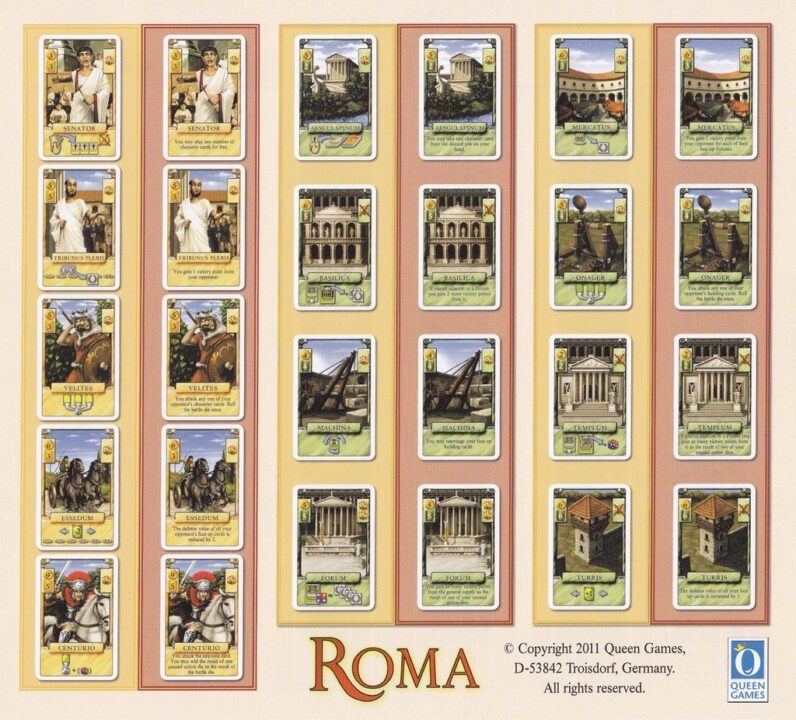
Component Quality and Design in Roma
Alright, let’s talk about the bits and pieces that come with Roma. The components of this game are a mixed bag, kinda like my cooking. You get some decent quality cards, which are nice and sturdy, so no worries about them getting bent out of shape during those intense game nights.
The artwork on the cards is, how do I put it, functional. It’s not going to win any beauty contests, but it does the job. The design is more utilitarian than eye-catching, but hey, as long as it’s clear, right? The icons and text are easy to read, which is always a plus when you’re trying to figure out which Roman character to play next.
Now, the dice and the game board, that’s where things get interesting. The dice are standard fare, nothing to write home about, but they roll well. The game board is small but well-laid-out. It might look tiny, but it keeps everything neat and organized, a bit like a Roman soldier’s camp.
One thing that did make me chuckle was the box insert. It’s like a puzzle trying to fit everything back in! But once you figure it out, it does keep all the components snug and secure.
So, would I recommend Roma based on the component quality and design alone? If you’re looking for something flashy, this might not be your game. But if you value functionality and durability, Roma’s got you covered. The real magic lies in the gameplay!
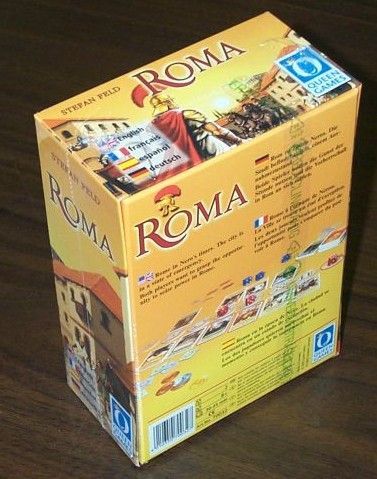
Conclusion
Alright folks, that wraps up our review of Roma. This game is a bit of a mixed bag. On one hand, you get a game with solid mechanics, great player interaction, and decent replayability. On the other hand, the component quality is functional but doesn’t dazzle you with bling. If you’re a fan of strategic gameplay with a bit of luck mixed in, Roma might just tick your boxes. But if you’re looking for a showstopper on your game shelf, it might fall short. Overall, I’d still recommend giving it a shot, especially if you’re into ancient Rome themes. Thanks for sticking around!

